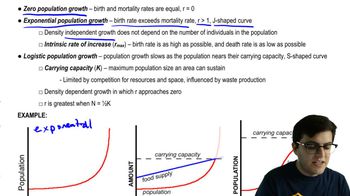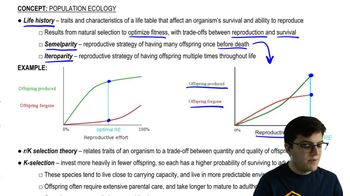Table of contents
- 1. Introduction to Biology2h 40m
- 2. Chemistry3h 40m
- 3. Water1h 26m
- 4. Biomolecules2h 23m
- 5. Cell Components2h 26m
- 6. The Membrane2h 31m
- 7. Energy and Metabolism2h 0m
- 8. Respiration2h 40m
- 9. Photosynthesis2h 49m
- 10. Cell Signaling59m
- 11. Cell Division2h 47m
- 12. Meiosis2h 0m
- 13. Mendelian Genetics4h 41m
- Introduction to Mendel's Experiments7m
- Genotype vs. Phenotype17m
- Punnett Squares13m
- Mendel's Experiments26m
- Mendel's Laws18m
- Monohybrid Crosses16m
- Test Crosses14m
- Dihybrid Crosses20m
- Punnett Square Probability26m
- Incomplete Dominance vs. Codominance20m
- Epistasis7m
- Non-Mendelian Genetics12m
- Pedigrees6m
- Autosomal Inheritance21m
- Sex-Linked Inheritance43m
- X-Inactivation9m
- 14. DNA Synthesis2h 27m
- 15. Gene Expression3h 20m
- 16. Regulation of Expression3h 31m
- Introduction to Regulation of Gene Expression13m
- Prokaryotic Gene Regulation via Operons27m
- The Lac Operon21m
- Glucose's Impact on Lac Operon25m
- The Trp Operon20m
- Review of the Lac Operon & Trp Operon11m
- Introduction to Eukaryotic Gene Regulation9m
- Eukaryotic Chromatin Modifications16m
- Eukaryotic Transcriptional Control22m
- Eukaryotic Post-Transcriptional Regulation28m
- Eukaryotic Post-Translational Regulation13m
- 17. Viruses37m
- 18. Biotechnology2h 58m
- 19. Genomics17m
- 20. Development1h 5m
- 21. Evolution3h 1m
- 22. Evolution of Populations3h 52m
- 23. Speciation1h 37m
- 24. History of Life on Earth2h 6m
- 25. Phylogeny2h 31m
- 26. Prokaryotes4h 59m
- 27. Protists1h 12m
- 28. Plants1h 22m
- 29. Fungi36m
- 30. Overview of Animals34m
- 31. Invertebrates1h 2m
- 32. Vertebrates50m
- 33. Plant Anatomy1h 3m
- 34. Vascular Plant Transport2m
- 35. Soil37m
- 36. Plant Reproduction47m
- 37. Plant Sensation and Response1h 9m
- 38. Animal Form and Function1h 19m
- 39. Digestive System10m
- 40. Circulatory System1h 57m
- 41. Immune System1h 12m
- 42. Osmoregulation and Excretion50m
- 43. Endocrine System4m
- 44. Animal Reproduction2m
- 45. Nervous System55m
- 46. Sensory Systems46m
- 47. Muscle Systems23m
- 48. Ecology3h 11m
- Introduction to Ecology20m
- Biogeography14m
- Earth's Climate Patterns50m
- Introduction to Terrestrial Biomes10m
- Terrestrial Biomes: Near Equator13m
- Terrestrial Biomes: Temperate Regions10m
- Terrestrial Biomes: Northern Regions15m
- Introduction to Aquatic Biomes27m
- Freshwater Aquatic Biomes14m
- Marine Aquatic Biomes13m
- 49. Animal Behavior28m
- 50. Population Ecology3h 41m
- Introduction to Population Ecology28m
- Population Sampling Methods23m
- Life History12m
- Population Demography17m
- Factors Limiting Population Growth14m
- Introduction to Population Growth Models22m
- Linear Population Growth6m
- Exponential Population Growth29m
- Logistic Population Growth32m
- r/K Selection10m
- The Human Population22m
- 51. Community Ecology2h 46m
- Introduction to Community Ecology2m
- Introduction to Community Interactions9m
- Community Interactions: Competition (-/-)38m
- Community Interactions: Exploitation (+/-)23m
- Community Interactions: Mutualism (+/+) & Commensalism (+/0)9m
- Community Structure35m
- Community Dynamics26m
- Geographic Impact on Communities21m
- 52. Ecosystems2h 36m
- 53. Conservation Biology24m
50. Population Ecology
Introduction to Population Ecology
Problem 15b
Textbook Question
Burmese pythons (Python molurus bivittatus) are constricting snakes that can reach enormous sizes (up to 7 meters in length). They are native to Southeast Asia but were released into southern Florida from the pet trade. Many other snakes occur naturally in this area. Are the introduced pythons a problem? Pythons are generalist predators, consuming a wide variety of prey including birds, mammals ranging from rodents to deer, and alligators. A road survey showed a 99 percent decrease in the frequency of raccoon and opossum observations within python areas from 2003 to 2011. Rabbits and foxes have also disappeared from the area. Do you think food availability limits, or could limit, the carrying capacity of Burmese pythons in the Everglades?
 Verified step by step guidance
Verified step by step guidance1
Identify the key ecological concept of carrying capacity, which is the maximum population size of a species that an environment can sustain indefinitely given the food, habitat, water, and other necessities available in the environment.
Analyze the diet of Burmese pythons as generalist predators, which means they can consume a wide variety of prey. This adaptability in diet could potentially support a large population in a new environment like the Everglades.
Consider the impact of pythons on local wildlife populations as indicated by the road survey. A significant decrease in the populations of native species like raccoons, opossums, rabbits, and foxes suggests that pythons are heavily preying on these animals.
Evaluate whether the reduction in native prey species could lead to a decrease in food availability for the pythons. If prey species continue to decline, the carrying capacity for pythons might be reached when there are insufficient prey to support a growing python population.
Discuss potential long-term ecological impacts if the python population continues to grow unchecked, potentially leading to further reductions in prey populations and alterations in the ecosystem structure and function.
Recommended similar problem, with video answer:
 Verified Solution
Verified SolutionThis video solution was recommended by our tutors as helpful for the problem above
Video duration:
1mPlay a video:
Was this helpful?
Key Concepts
Here are the essential concepts you must grasp in order to answer the question correctly.
Invasive Species
Invasive species are non-native organisms that, when introduced to a new environment, can disrupt local ecosystems. They often outcompete native species for resources, leading to declines in biodiversity. Burmese pythons, as an invasive species in Florida, have significantly impacted local wildlife populations, demonstrating the ecological consequences of introducing non-native predators.
Recommended video:

Biological Species Concept
Carrying Capacity
Carrying capacity refers to the maximum number of individuals of a species that an environment can sustainably support, based on available resources such as food, water, and habitat. In the context of Burmese pythons, their carrying capacity in the Everglades may be influenced by the availability of prey species, which has been drastically reduced due to predation and competition.
Recommended video:
Guided course

Estimating Earth’s Human Carrying Capacity
Trophic Cascade
A trophic cascade is an ecological phenomenon triggered by the addition or removal of top predators, which can lead to significant changes in the structure and function of an ecosystem. The introduction of Burmese pythons has likely initiated a trophic cascade in the Everglades, resulting in the decline of mesopredators like raccoons and opossums, which can further affect plant and animal populations in the area.
Recommended video:
Guided course

Phosphorylation Cascades

 1:17m
1:17mWatch next
Master Population Ecology with a bite sized video explanation from Jason Amores Sumpter
Start learningRelated Videos
Related Practice



































































